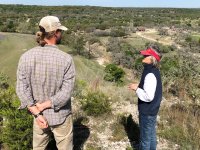Lee Rinehart
Member
I received a question during the Soil for Water Film Premiere with Panel Discussion on February 17, and I wanted to share some resources based on the question. IB wrote, “are there any tips or resources you can give us for those who are on hilltops for retaining water?
If you are growing crops, permaculture can be a great way to retain water on hilltops. Techniques you could think about include planting deep rooted perennials as a basis for the garden/crop production, creating swales, berms, and terraces, using Hugelkultur or mound culture, and rainwater harvesting. A good source of information is Permaculture Design Notes from the Permaculture Institute. See also the industry standard Permaculture A Designers Manual by Bill Mollison.
For hilltop pastures, maintaining a dense sward of diverse grasses and forbs is the best way to ensure water retention. The ATTRA publication Building Healthy Pasture Soils goes into detail on practices to build aggregation and good soil structure, which allows soil to act like a sponge instead of a brick. Also, there are certain engineering practices you can do to prevent or control runoff, and the NRCS has practice standards that can provide technical and financial assistance to install practices like livestock walkways, contour farming, dams and diversions, hillside ditches, and terraces. Start by contacting an NRCS Conservationist at one of the USDA Service Centers.

If you are growing crops, permaculture can be a great way to retain water on hilltops. Techniques you could think about include planting deep rooted perennials as a basis for the garden/crop production, creating swales, berms, and terraces, using Hugelkultur or mound culture, and rainwater harvesting. A good source of information is Permaculture Design Notes from the Permaculture Institute. See also the industry standard Permaculture A Designers Manual by Bill Mollison.
For hilltop pastures, maintaining a dense sward of diverse grasses and forbs is the best way to ensure water retention. The ATTRA publication Building Healthy Pasture Soils goes into detail on practices to build aggregation and good soil structure, which allows soil to act like a sponge instead of a brick. Also, there are certain engineering practices you can do to prevent or control runoff, and the NRCS has practice standards that can provide technical and financial assistance to install practices like livestock walkways, contour farming, dams and diversions, hillside ditches, and terraces. Start by contacting an NRCS Conservationist at one of the USDA Service Centers.






